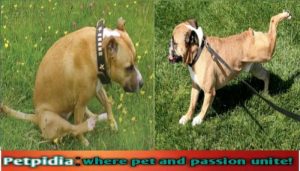Why Do Dogs Get the Zoomies After Pooping? Dogs often Get the Zoomies After Pooping due to a burst of energy from the relief and comfort of emptying their bowels. This behavior, known as “post-elimination behavior,” is common and generally harmless.
Table of Contents
Toggle
Experiencing a sudden surge of energy, dogs frequently exhibit a peculiar behavior known as the zoomies, where they race around with no apparent direction. This burst of activity often occurs after they have successfully gone to the bathroom, and it’s not only adorable but also quite normal for our canine companions.
It is believed that this behavior is associated with the feeling of lightness and relief following defecation. Experts suggest that the zoomies can be a way for dogs to express their happiness or to mark their territory with the scent glands in their feet.
This phenomenon is so widespread that it has earned the term FRAPs, which stands for Frenetic Random Activity Periods. Understanding these quirky displays of energy is part of the joy of dog ownership, offering a window into the well-being and emotions of our furry friends.

Why Do Dogs Get the Zoomies After Pooping? |The Zoomies Phenomenon
What Are The Zoomies?
In scientific terms, the zoomies are known as FRAPs – Frenetic Random Activity Periods. They are characterized by sudden, intense energy bursts where dogs run in circles, dash back and forth, or spin around. Usually, this spontaneous whirl of activity is full of joy and often happens during times of excitement or relief.
Behavioral Patterns Post-pooping
- Relief and Happiness: Pooping can make a dog feel happier and more comfortable.
- Instinctual Behavior: Wild ancestors may have run to scatter their scent or avoid predators.
- Physical Stimulation: The act of pooping can stimulate the dog’s body and provoke the reaction.
Physiological Triggers
Nerve Stimulation During Bowel Movements
The act of pooping can activate nerves within your dog’s body. These nerves send signals that could cause a rush of energy. Here’s what happens:- Stimulation of nerves: as feces move through the colon, they stimulate nerves.
- Release of energy: this nerve action can produce a sudden surge of happiness.
The Role Of The Vagus Nerve
The vagus nerve connects the brain to many parts of the body, including the colon. During bowel movements, this nerve can become stimulated.- Connection to emotions: the vagus nerve influences your dog’s emotions.
- Zoomies: stimulation may lead to the burst of joy we see as zoomies.
Why Do Dogs Get the Zoomies After Pooping? please, look the video!
Psychological Aspects
Relief And Satisfaction
The sense of relief after pooping is noteworthy in dogs. This is akin to the feeling humans experience, a release of discomfort. Dogs might express this sudden comfort through joyful running, turning their relief into an exuberant physical display. This behavior emphasizes their instinct to celebrate a feeling of lightness and comfort.Conditioned Behavior Patterns
Many dog habits form through repetition and conditioning. Zoomies might represent a conditioned response tied to the sense of accomplishment post-potty. Whether it’s through positive reinforcement from owners or a self-rewarding feeling, dogs might adopt these antics as part of their routine behavior pattern, reinforcing joyous zoomies as a natural consequence of their actions.Territorial Marking Theories
Scent Marking And The Zoomies
The act of pooping does more than relieve your dog; it leaves their unique scent behind. This process is crucial in the wild, where canines mark their territory. The zoomies may be a vestige of displaying dominance or ensuring other animals know an area has been claimed.- Delivering a Message: A quick sprint after pooping helps spread their scent, reinforcing the mark.
- Engaging Glands: Dogs have anal glands that release additional scents, and the zoomies could stimulate these glands more effectively.
- Physical Expression: A joyous run symbolizes a successful territorial claim.
Dogs’ Communication Through Movement
Movement is a key communication tool for dogs. Post-poop zoomies might be a dog’s way of expressing a mix of feelings from relief to joy or playing their part in an instinctual ritual of messaging other dogs through body language and movement.- Expression of Well-being: Healthy dogs often run after pooping, signaling their vitality.
- Invitation to Play: This sudden burst of energy might welcome others to engage or play.
- Celebration of Relief: Feeling lighter, dogs may spontaneously frolic, showing a sense of freedom.
Evolutionary Perspectives
Wild Ancestors And Modern Dogs
Modern dogs descend from wild ancestors. Studying these ancestors reveals clues about today’s pet behaviors. Post-poop ‘zoomies’, or Frenetic Random Activity Periods (FRAPs), can be traced back to those primal canines. Their everyday actions were geared toward survival and safety after vulnerable moments.Survival Instincts Influencing Behavior
The act of pooping leaves dogs in a delicate position. Wild instincts kick in to move swiftly from the spot, minimizing traces of presence. This could deter predators and protect their territory from rivals. This behavior has carried over to domestic dogs, manifesting as joyful sprints post-potty time. It is an instinctive act mingled with the physical relief of lightening their load.- Evading Predators: Quick moves ensured safety after being stationary.
- Marking Territory: Speedy departures helped spread their scent further.
- Muscle Relief: Movement relaxes muscles post-defecation.
Health Implications
Identifying Normal Versus Excessive Zoomies
Normal zoomies are short, happy bursts of speed where your dog may run in circles or back and forth, typically lasting a few seconds to a couple of minutes. This behavior is often just a sign of a relieved and happy pup. Excessive zoomies might look different. Signs to watch for include:- Duration: Lasting much longer than a few minutes.
- Frequency: Occurring after every bathroom trip.
- Behavior: Paired with unusual actions like excessive licking or biting their rear.
When To Consult A Vet
Pay attention to your dog’s post-poop behavior. It’s important to know when to get professional advice.| Zoomie Behavior | Action Needed |
|---|---|
| Normal Zoomies | No action, just fun |
| Excessive Zoomies | Consult Your Vet |
| Paired with Discomfort | Consult Your Vet Immediately |
Influence Of Diet On Digestion And Behavior
Nutritional Factors
High-quality nutrients matter for your dog’s overall health. Dogs need a balanced diet just like us. Their meals should be full of protein, fiber, and the right fats to support their energy levels. A poor diet can lead to digestive problems, making them feel uncomfortable. Once relieved, they may express their comfort exuberantly!- Protein – Builds muscles and provides sustainable energy.
- Fiber – Aids in smooth digestion, leading to comfortable poops.
- Healthy Fats – Fuels their frolics and supports brain health.

Foods That Can Affect Energy Levels
Different foods can boost your dog’s vigor. Think of them as their fuel. The right kind keeps their engine running smoothly, and the wrong kind might cause a hilariously wild zoom after potty time.| Food Type | Energy Impact |
|---|---|
| Whole Grains | Long-lasting energy |
| Raw Foods | Quick energy release |
| Processed Treats | Possible energy spikes and slumps |
Training And The Zoomies
Managing Post-pooping Excitement
- Identify the triggers that set off your dog’s behavior.
- Maintain a calm and routine environment post-bathroom.
- Post-poop play sessions can channel energy positively.
Tips For Handling An Overexcited Dog
| Tip | Benefit |
|---|---|
| Engage in calming activities | Reduces excess energy |
| Use consistent commands | Improves listening skills |
| Offer treats for calm behavior | Encourages good habits |
Owners’ Anecdotes
Have you ever watched your furry friend suddenly sprint around wildly after a potty break? This phenomenon is fondly dubbed as the ‘zoomies,’ and dog owners everywhere relate to it. Here, we gather delightful stories that showcase this quirky behavior. These narratives offer a window into the joy and hilarity that our pets bring. They remind us of the unique bond shared between dogs and their humans.
Sharing Stories Of Zoomies
We’ve all seen it – that burst of energy in dogs, leaving us with smile-filled faces. Owners exchange tales of their dogs’ zoomies, finding solace in knowing they’re not alone. From puppies to elder dogs, the zoomies seem to spare no one. These moments are so special that they often become treasured memories, passed on between pet lovers with laughter and nods of agreement.
- Poodles pirouetting post-poop,
- Labradors leaping after a loo break,
- And terriers tearing around the yard.
Each story echoes the same endearing sentiment: dogs will be dogs, full of life and uncontainable joy.
Community And Understanding Our Pets
Sharing these zoomie stories does more than provide entertainment. It fosters a sense of community among dog lovers. This exchange of experiences builds a shared understanding of our canine companions. It’s a reminder that while each dog is special, many behaviors like the zoomies are universal. Dissecting the reasons behind this common act strengthens our connection with our pets. It helps us appreciate the simple things, like a good stretch of the legs after taking care of business. We learn, we laugh, and we love our pets all the more for their spontaneous expressions of happiness.

Embrace the zoomies. Cherish those fast-paced moments. They’re pure, they’re natural, and they’re a testament to the spirited lives our dogs lead. Through thunderous sprints and dizzying dashes, our pets show us the art of living in the now. And what a wonderful art that is.
Frequently Asked Questions Of Why Do Dogs Get The Zoomies After Pooping?
What Triggers Dogs To Get Zoomies?
Zoomies in dogs, termed ‘FRAPs’ (Frenetic Random Activity Periods), are sparked by a surge in energy levels. This often happens after they’ve finished going to the bathroom, as a way of expressing relief or happiness.
Can All Dog Breeds Experience Zoomies?
Yes, all dog breeds can experience zoomies, regardless of size or age. It is a natural behavior that reflects a burst of energy and is common among canines.
How Often Do Zoomies Occur In Dogs?
Zoomies are not a daily activity for most dogs and can occur a few times a week or less. The frequency might increase with triggers like bath time or excitement.
Are Zoomies A Sign Of Good Health In Dogs?
Generally, zoomies are a sign of a healthy and energetic dog. However, if they’re excessive or seem compulsive, it might be worth discussing with a vet to rule out any underlying issues.
Conclusion
Understanding the quirky behavior of our canine companions can be both amusing and perplexing. The burst of energy dogs display post-potty, known as the ‘zoomies,’ is a harmless and normal way for them to express relief and happiness. As pet owners, embracing these joyful moments can deepen the bond with our furry friends. Remember, a happy dog with the zoomies is a healthy, spirited companion on life’s exciting journey.


1 thought on “Why Do Dogs Get the Zoomies After Pooping?”